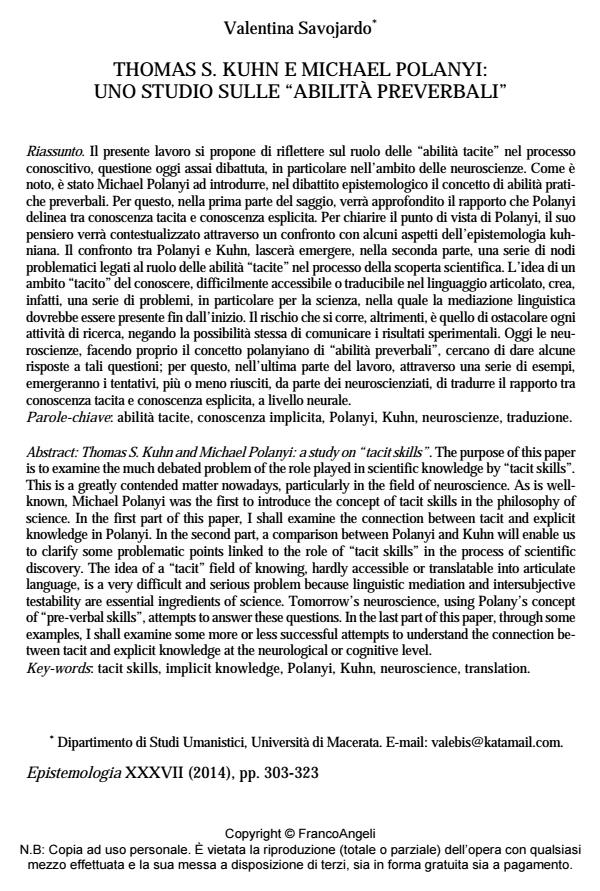Thomas S. kuhn e Michael Polanyi: uno studio sulle "abilità preverbali"
Titolo Rivista EPISTEMOLOGIA
Autori/Curatori Valentina Savojardo
Anno di pubblicazione 2015 Fascicolo 2014/2
Lingua Italiano Numero pagine 21 P. 302-323 Dimensione file 91 KB
DOI 10.3280/EPIS2014-002009
Il DOI è il codice a barre della proprietà intellettuale: per saperne di più
clicca qui
Qui sotto puoi vedere in anteprima la prima pagina di questo articolo.
Se questo articolo ti interessa, lo puoi acquistare (e scaricare in formato pdf) seguendo le facili indicazioni per acquistare il download credit. Acquista Download Credits per scaricare questo Articolo in formato PDF

FrancoAngeli è membro della Publishers International Linking Association, Inc (PILA)associazione indipendente e non profit per facilitare (attraverso i servizi tecnologici implementati da CrossRef.org) l’accesso degli studiosi ai contenuti digitali nelle pubblicazioni professionali e scientifiche
Il presente lavoro si propone di riflettere sul ruolo delle "abilità tacite" nel processo conoscitivo, questione oggi assai dibattuta, in particolare nell’ambito delle neuroscienze. Come è noto, è stato Michael Polanyi ad introdurre, nel dibattito epistemologico il concetto di abilità pratiche preverbali. Per questo, nella prima parte del saggio, verrà approfondito il rapporto che Polanyi delinea tra conoscenza tacita e conoscenza esplicita. Per chiarire il punto di vista di Polanyi, il suo pensiero verrà contestualizzato attraverso un confronto con alcuni aspetti dell’epistemologia kuhniana. Il confronto tra Polanyi e Kuhn, lascerà emergere, nella seconda parte, una serie di nodi problematici legati al ruolo delle abilità "tacite" nel processo della scoperta scientifica. L’idea di un ambito "tacito" del conoscere, difficilmente accessibile o traducibile nel linguaggio articolato, crea, infatti, una serie di problemi, in particolare per la scienza, nella quale la mediazione linguistica dovrebbe essere presente fin dall’inizio. Il rischio che si corre, altrimenti, è quello di ostacolare ogni attività di ricerca, negando la possibilità stessa di comunicare i risultati sperimentali. Oggi le neuroscienze, facendo proprio il concetto polanyiano di "abilità preverbali", cercano di dare alcune risposte a tali questioni; per questo, nell’ultima parte del lavoro, attraverso una serie di esempi, emergeranno i tentativi, più o meno riusciti, da parte dei neuroscienziati, di tradurre il rapporto tra conoscenza tacita e conoscenza esplicita, a livello neurale.
Parole chiave:Abilità tacite, conoscenza implicita, Polanyi, Kuhn, neuroscienze, traduzione.
Valentina Savojardo, Thomas S. kuhn e Michael Polanyi: uno studio sulle "abilità preverbali" in "EPISTEMOLOGIA" 2/2014, pp 302-323, DOI: 10.3280/EPIS2014-002009